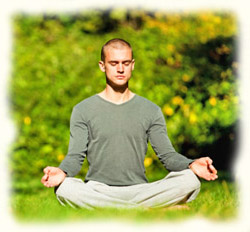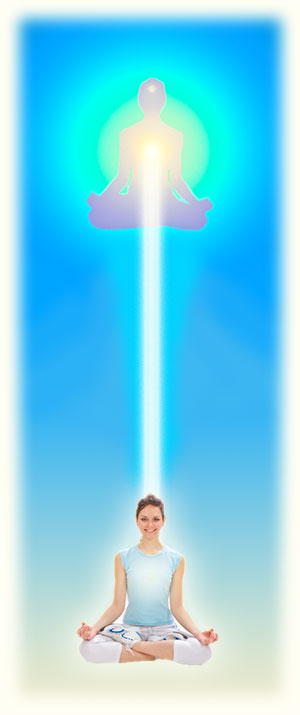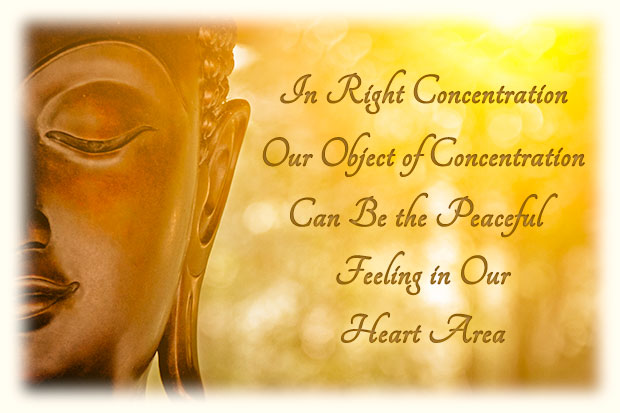

More on:
#8 Right Concentration
"Right Mindfulness" and "Right Concentration" are two slightly different approaches to meditating and right living that work towards the same transcendent goal: awakening into the blissful inner peace and awareness of our own Inner Buddha Nature. Right Mindfulness involves a gentle, soft awakening into a serene "awareness" of something that already is naturally existing - the inner peace that exists within our heart area and the "aliveness of the present moment". But, if we're feeling kind of agitated and find it difficult to contact that awareness of  inner peace, then we will need to take the more concentrated approach of "Right Concentration" in order to quiet the "monkey mind'', and thus reach the desired level of inner peace.
inner peace, then we will need to take the more concentrated approach of "Right Concentration" in order to quiet the "monkey mind'', and thus reach the desired level of inner peace.
Thus, "Right Concentration" involves a much more concentrated activity of will power which moves us into that place of quiet awareness. Consequently, we take a much more deliberate and active role in purposely focusing our natural powers of concentration on a single object or activity (the "object of concentration") in order to bring us to this same place of quiet awareness.
It is helpful to note here, though, that despite this distinction between "Right Mindfulness" & "Right Concentration" meditative approaches, they are sort of the other half of the same coin. And they can easily be used simultaneously to attain the desired goal of meditative awareness. Plus, there's no real line of demarcation between the activities of Right Mindfulness and Right Concentration. They sort of blend into each other all across the board. Some people find it easier and more successful to use the Right Mindfulness approach to meditation and mindful living, while others find it easier and more successful to use the Right Concentration approach. And of course, some people like to blend them together. It's not a big deal. Do whatever works best for you. Obviously, it's the results that count, not the specific techniques we use. For instance, the Zen Meditation known as "Zazen", uses primarily the highly focused "Right Concentration" approach. Whereas, "Mindfulness Meditation" usually follows the softer, gentler "Right Mindfulness" approach. Use whichever one works best for you, or blend them together, or combine them with other meditation techniques.
And just like "Right Mindfulness", there are two ways of applying the techniques of "Right Concentration" in our lives: A) When Meditating, and, B) When engaged in everyday living:
A) While meditating, "right concentration" refers to a "single pointed awareness" on an "object of concentration" that results in a quiet, peaceful state of equanimity. For example, attaining a peaceful state of inner serenity by quietly observing the peaceful flow of the breath in and out of our bodies; or focusing ones' attention on a flower; concentrating on an image of the Buddha; or visualizing the Light within one's Heart Chakra.
B) But, when engaged in the normal activities of living, "right concentration" simply means sincerely applying the first 7 elements of The Eightfold Path in every aspect of our lives in a very sincere, focused, conscious and mindful way.
In teaching "Right Concentration" the Buddha usually encouraged practitioners to chose an "object of concentration" and to meditate on it with a gentle, single pointed awareness. For instance, we might focus on the peacefulness of our breathing, (in this case the breath is the object of concentration). As we gently focus on feeling the relaxing, softness of the breath flowing in and out of our lungs, it gradually quiets the mind. Similarly we can quietly focus with one-pointed concentration  on a flower; a statue of the Buddha; visualize the golden white light within our heart area, and so on. But, no matter the object of concentration, the technique is similar. We expand our awareness of inner peace by gently focusing on the feelings and sensations of inner peace and relaxation associated with the in-flow and out-flow of the breath, or whatever is the object of concentration (perhaps we're focusing on letting go of all tension in our shoulder muscles and blissfully letting them softly relax). If unwanted thoughts arise, such as worries, anxieties, hurries, selfish desires or attachments, we simply and quietly observe them in a way that is similar to ignoring them. It is extremely important not to fight them, but instead to simply observe them without caring about them and without investing any emotional energy into them. They simply come and go. It's no big deal. Who cares? When we take that attitude they usually fade away on their own.
on a flower; a statue of the Buddha; visualize the golden white light within our heart area, and so on. But, no matter the object of concentration, the technique is similar. We expand our awareness of inner peace by gently focusing on the feelings and sensations of inner peace and relaxation associated with the in-flow and out-flow of the breath, or whatever is the object of concentration (perhaps we're focusing on letting go of all tension in our shoulder muscles and blissfully letting them softly relax). If unwanted thoughts arise, such as worries, anxieties, hurries, selfish desires or attachments, we simply and quietly observe them in a way that is similar to ignoring them. It is extremely important not to fight them, but instead to simply observe them without caring about them and without investing any emotional energy into them. They simply come and go. It's no big deal. Who cares? When we take that attitude they usually fade away on their own.
During "Right Concentration" we find that without really thinking about it, we're coming "down out of our thoughts" and into our heart area, (or into our relaxing shoulder muscles, or whatever). Because of this, this  process is sometimes referred to as "coming into the body", since we're shifting our attention from our thoughts and worries to the gentle feeling of our breath going in and out of our lungs; (or into our relaxing shoulder muscles; or into the peaceful energy fields of the heart area). The "body" in this case might refer either to our muscles, or to the peaceful energy field that we feel around our heart chakra. This is because the peaceful energy field associated with our heart chakra is actually a part of our inner "light body", which in certain lineages of Mahayana Buddhism is connected to our Higher Self, the "Tathagatagarbha" or "Inner Buddha Nature".
process is sometimes referred to as "coming into the body", since we're shifting our attention from our thoughts and worries to the gentle feeling of our breath going in and out of our lungs; (or into our relaxing shoulder muscles; or into the peaceful energy fields of the heart area). The "body" in this case might refer either to our muscles, or to the peaceful energy field that we feel around our heart chakra. This is because the peaceful energy field associated with our heart chakra is actually a part of our inner "light body", which in certain lineages of Mahayana Buddhism is connected to our Higher Self, the "Tathagatagarbha" or "Inner Buddha Nature".
It may also be helpful to know that the peacefulness that one feels around the heart chakra while watching the breath is actually the very same peacefulness that is associated with the golden white light which gently pours out of the heart chakra to bless all life as the feeling of loving kindness. Likewise, it is a lesser version of the peacefulness that one feels when pouring love to one's Tathagatagarbha - one's Higher Buddha Nature, our Higher Self; to the Universal Buddha Nature; to Amitabha Buddha in the devotional Pure Land Buddhist Paths; or to GOD in Western & Hindu paths.
In the branches of Mahayana Buddhism that recognizes the existence of the Higher Self as the Tathagatagarbha, the "object of concentration might be the Tathagatagarbha itself. In this case "right concentration" might take the form of a gentle, one-pointed awareness or mindfulness of the blissful, wholesome flow of loving kindness pouring down into our heart chakra from our Higher Self or Tathagatagarbha as it flows on its peaceful way out into the world to bless all sentient beings. Likewise, it might also involve the gentle, blissful, single-minded awareness of the feeling of grateful loving devotion flowing from our own heart back up into our Tathagatagarbha or Higher Self. By staying in a quiet state of mindfulness, we can experience both flows simultaneously - the flow from our Tathagatagarbha out through our hearts to bless all life with the feeling of loving kindness, while simultaneously feeling the loving devotion flowing from our heart chakras back up to our Higher Self, the Tathagatagarbha. When practiced sincerely, this type of meditation eventually will become quite blissful. The Buddha taught that the path of the Buddha is a path of peaceful, blissful happiness, and there's probably no easier and more fruitful way of gently awakening into this peaceful bliss than this kind of meditation. Click here for more insights on these kinds of "Devotional Meditations".
Some people may at first wonder if it is okay to be experiencing such blissful, peaceful happy feelings. So it might be helpful here to distinguish between experiencing "human pleasures" and experiencing the "divine bliss of one's Buddha Nature." The Buddha taught that selfishly and endlessly chasing after worldly pleasures can be one of the primary causes of suffering. On the other hand, quietly experiencing divine bliss as we practice mindfulness or some other Buddhist meditation is one of the highest, purest activities of our Buddha Nature. So it's important to know this difference, in order to give ourselves permission to experience this wholesome kind of blissful happiness which is such a blessing for us and which naturally and gradually moves us ever further into the ultimate state of Nirvana.
As one can see, the sincere, sustained use and practice of Right Mindfulness or Right Concentration, or both, is a wonderful way of letting go of our hurries, worries, selfish desires and attachments, quieting our minds, and gradually awakening into the bliss of our Inner Buddha Nature.
* * *

* * *
Back to the Buddha's Path Table of Contents
* * *
Copyright 2020 Bill Gaum All Rights Reserved